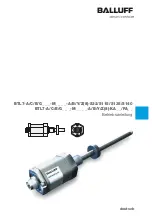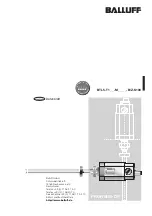
DETAILED DESCRIPTION
2-22
General Description:
The function of FD1236A is to provide feedback signals for amplitude and phase correction of
the 90 and 150 Hz modulated RF signals. Two dual directional couplers sample the main RF
signal from the 90 Hz and the 150 Hz modulated power amplifiers, respectively. One half of
each dual coupler is used for amplitude control, while the other half is used for phase control.
For AMPLITUDE control, the sampled RF signal is detected by a diode that is slightly forward
biased for linearity, bias being provided by another diode. The detector time constant is short;
the detected signal consist of a positive voltage proportional to the RF carrier level and an LF
voltage proportional to the modulation. When this output is fed back to the power amplifiers
via the Amplitude Control board, RF power and modulation depth will be held constant, and
distortion will be practically eliminated. A low-pass filter is inserted between the detector diode
and the coupled lines to prohibit RF harmonics generated by the detector to couple back onto
the main RF line. Coupler directivity is much improved by very small capacitances connected
across the lines.
For PHASE control, a 90 degree 3 dB hybrid is used as a phase discriminator. Such a device
has the property that the resulting amplitude at its outputs depend upon the phase difference
at its inputs. Here, the two sampled RF signals, which have equal amplitudes, are applied to
the hybrid inputs. The two output signals from the hybrid are rectified, giving positive output
voltages with some LF components. Normally, these two voltages will be equal. Any shift in
RF input phase will make these voltages unequal. When these output voltages are fed back to
the Phase Control board, the phase relations at the input will be held constant. For equal mag-
nitude at the outputs of the 90 degree 3 dB hybrid, the phase difference at the hybrid inputs
must be zero. Proper phasing initially is here obtained by the insertion of a delay line in the
150 Hz modulated path. The main RF input signals applied to the couplers are already 90
degrees out of phase here, with the 90 Hz modulated signal lagging. Therefore, the additional
delay line between the 150 Hz coupler and the hybrid will provide the missing 90 degree delay
for zero phase difference at the hybrid inputs. A small trimming capacitor is included to facili-
tate an offset to compensate for eventual minor phase errors in the remaining RF circuitry out-
side the phase feedback loop. Adjustment can therefore only be done properly with the whole
transmitter module working. This trimmer is the only adjustable component on this board. All
diodes used on this board are matched pairs for temperature stability reasons.
The RF power output from this board is fed through a pair of 50 Ohm coaxial connections
inside the housing directly to the Combiner board CD1238A, the connections being discon-
nectable to facilitate removal for repair. Inserted in a properly adjusted transmitter module, the
90 and 150 Hz modulated output (and input) power signals of the Feedback Detector board
will have equal amplitudes with the 90 Hz path lagging the 150 Hz path by 90 degrees (except
for eventual offset), and this condition will be held constant by the feedback loops.
2.4.5.1 FD1224A Feedback detector
General Description :
The function of FD1224A is to provide a feedback signals for amplitude correction of the com-
posite 90 Hz and 150 Hz modulated RF signal for GP Clearance, and to provide a detected
output of this signal for measurement purposes.
A directional coupler samples the main RF signal from the power amplifier, which is modu-
lated with both 90 and 150 Hz in this case.
The sampled RF signal is detected by a diode that is slightly forward biased for linearity, bias
being provided by another diode. The detector time constant is short; the detected signal con-
sist of a positive voltage proportional to the RF carrier level and an LF voltage proportional to















































